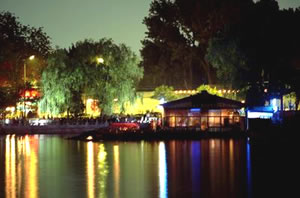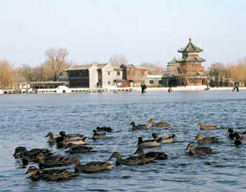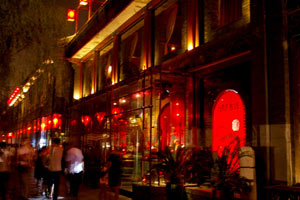Just as different people look different, different cities naturally have their own distinctive image. Take Shanghai for example, talking of the city can make people think of the famous song Shanghai at Night where the vanity of the old city is apparent. And peaceful boating in the lit Qinhuai River remains the stereotype of the ancient capital city of Nanjing in people's mind even though that activity has been replaced by noisy crowds of visitors in spite of the pseudo-classic gaily-painted pleasure boats still running to and fro on the river.
 Speaking of Beijing, what easily comes to mind are the Forbidden City with its red walls and green tiles, the Beijing dialect from the quadrangle houses, and the undulating and majestic Great Wall. The weight of its history accumulated over time has offset the image of the modern city that it has become.
Speaking of Beijing, what easily comes to mind are the Forbidden City with its red walls and green tiles, the Beijing dialect from the quadrangle houses, and the undulating and majestic Great Wall. The weight of its history accumulated over time has offset the image of the modern city that it has become.
In reality, one needs time as well as energy to discover the real behind the imagined in a city, just as one does with a person.
Ancient Shichahai surrounded by temples
On a map of Beijing which marks the fourth and fifth ring roads and even the sixth ring road now under construction, only limited water areas can be seen. But interestingly enough, all these water areas have the name "hai" meaning sea e.g, Beihai, Zhongnanhai and Shichahai. It is said that this has something to do with nomadic Mongolians. Generations of Mongolians lived in inland areas where they called a water area “hai” or “haizi” meaning lake instead of sea.
The water area of Shichahai was called "haizi" prior to the Yuan Dynasty (1279-1368). It consisted of Xihai, Qianhai and Houhai which were unknown to the public. With Beihai Lake becoming an imperial backgarden, some 20 temples were built in the area of Shichahai Lake. It was said that these temples were established for the convenience of women to leave the imperial families. "Cha" refers to a small temple while "shi" can mean "tens", hence the name of Shichahai.
 About six months ago, Shichahai was just a peaceful town of the increasingly modernized metropolis of Beijing. On a sunny afternoon, you could go to Shichahai from any place, Deshengmen or Di’anmen. Roaming about the labyrinth of hutongs (lanes), you might hardly imagine that this place used to be festooned with temples. Guanghua Temple which was built during the Yuan Dynasty now serves as the premises of the Beijing Buddhism Association.
About six months ago, Shichahai was just a peaceful town of the increasingly modernized metropolis of Beijing. On a sunny afternoon, you could go to Shichahai from any place, Deshengmen or Di’anmen. Roaming about the labyrinth of hutongs (lanes), you might hardly imagine that this place used to be festooned with temples. Guanghua Temple which was built during the Yuan Dynasty now serves as the premises of the Beijing Buddhism Association.
Grey courtyard walls, lush and green willow trees, quiet water…all this displays the generosity of this city. Occasionally you might come across some fashionably dressed young people, humming a pop tune while riding a bicycle. They join Beijing natives who eat hand-made noodles, listen to stories in their Beijing dialect accompanied by drums, wear traditional-styled shoes and collarless shirts, the details best characterizing Beijing.
Yuan Haowen (1190-1257), an outstanding writer of the Kin era (1115-1234); Nalan Xingde (1655-1685), a writer of ci poetry in the Qing Dynasty; Lu Xun (1881-1936), father of Modern Chinese Literature; Lao She (1899-1966), China’s master storyteller… and even that foreigner Marco Polo wrote verse and essays about the place, recording its past between the lines of history. Today they have become an indispensable part of Shichahai, adding another cultural foundation layer to its history. Together with the quadrangles, ancient temples and lake, they constitute the history of Shichahai.
While strolling among the hutongs, you'll constantly encounter tourists of different sorts who are taking hutong culture tours by pedicabs. Amid these grey quadrangle groups are hidden a number of homes of former celebrities including Prince Gong’s Mansion, the residence of Soong Ching Ling, wife of Dr Sun Yat-sen and China's late honorary president, the residence of Guo Muruo (poet), and the residence of Mei Lanfang (great master of Peking Opera). They naturally add a charm to Shichahai. It is therefore not surprising to find residents of many different demeanors.
Yinding Bridge
 The eight scenic attractions in Beijing designated by Emperor Qianlong of the Qing Dynasty (1644-1911) were: Autumn Winds on Taiye (current Zhongnanhai), Jade Islet in Shady Springtime, the Golden Terrace in the Glow of the Setting Sun, Trees Enveloped in Mist at the Ancient City of Jizhou, the Western Hills Shimmering in Snow, the Rainbow Floating over the Jade Spring, the Moon over the Lugou Bridge at Dawn and the Great Wall Surrounded by Lush Greenery at the Juyong Pass. The sight of Observing Mountains from Yinding Bridge was not included. Since the Republic of China (1912-1949), few of these eight attractions have remained. But native Beijingers have been inclined to include Observing Mountains from Yinding Bridge among them. Today when you stand on the Yinding Bridge, you can hardly believe the magnificent sight of observing the Western Hills in the distance, the vast stretches of water and reeds, and ships in the Beijing-Hangzhou Grand Canal busy transporting grain. But Yinding Bridge remains a scenic attraction of importance at Shichahai.
The eight scenic attractions in Beijing designated by Emperor Qianlong of the Qing Dynasty (1644-1911) were: Autumn Winds on Taiye (current Zhongnanhai), Jade Islet in Shady Springtime, the Golden Terrace in the Glow of the Setting Sun, Trees Enveloped in Mist at the Ancient City of Jizhou, the Western Hills Shimmering in Snow, the Rainbow Floating over the Jade Spring, the Moon over the Lugou Bridge at Dawn and the Great Wall Surrounded by Lush Greenery at the Juyong Pass. The sight of Observing Mountains from Yinding Bridge was not included. Since the Republic of China (1912-1949), few of these eight attractions have remained. But native Beijingers have been inclined to include Observing Mountains from Yinding Bridge among them. Today when you stand on the Yinding Bridge, you can hardly believe the magnificent sight of observing the Western Hills in the distance, the vast stretches of water and reeds, and ships in the Beijing-Hangzhou Grand Canal busy transporting grain. But Yinding Bridge remains a scenic attraction of importance at Shichahai.
Written records show that Yinding Bridge was a wooden bridge at the beginning and got its name from looking like a silver ingot. In later years, it underwent repeated renovation and was finally transformed into a stone bridge with a white marble arch.
In the evening, standing on the Yinding Bridge provides the best view of Shichahai Lake. The no longer wide waters meet under Yinding Bridge from two directions. In summer, visitors prefer to go boating on the lake and songs and music can be faintly heard coming from them. Some young people like to float small paper boats with lit candles inside on the water. All of sudden, it gives the feeling of boating on the Qinhuai River in Nanjing. Although the pleasure boats and tourists bring noise to the peaceful Shichahai Lake, it's perhaps the way it is.
It's not difficult to envisage that the Beijing-Hangzhou Grand Canal finally ended here. Everyday the coming ships carrying grain from the places south of the Yangtze River anchored here. The two banks of the lake were naturally crowded with stores and wineshops which were never deserted. Although a lot of people and things are forgotten, the importance of Shichahai will never be among them. The saying "Shichahai came before the city of Beijing" is one of evidence.
There are no longer grain ships anchored, but Ji's Grill, a time-honored restaurant on the lake's bank, has continued to enjoy a brisk business. Qingyun Restaurant from those days has already disappeared, but a nostalgic person opened a restaurant called Nuage. Nuage is French for cloud (yun in Chinese). It is said that the name was given in memory of the Qingyun Restaurant. The interior decoration uses a cloud pattern by accident or not, which is unknown. Although it has nothing to do with the past, it is a kind of commemoration of Shichahai's past by the people of today. A city, if it goes without its history, will lose its origin and soul; and if a city's history can't be remembered, it might be equal to a city without a history.
Peddlers selling flowers or other small articles can always be seen nearby the Yinding Bridge. This seems to be out of tune with the increasingly rich petty bourgeois atmosphere of the Shichahai area. But it is because of this inharmony that Shichahai reduces something delicate from its past and increases something secular, restoring it to something like the way it was.
Bar street
Thanks to the outbreak of the SARS epidemic this year, and according to the analysis of some people, the business on the bar street of Shichahai has been extremely brisk as people began to pay attention to the relationship between environment and life. Perhaps this analysis really agrees with its history, but just like many others, I'm inclined to believe that the charm of Shichahai lies in its unique culture.
 There were already a few bars in the Shichahai area several years ago. On summer nights, it was a really special treat to chats with friends over tea under the dim light inside a small bar by the lake, sitting next to a window. Occasionally you may hear gossip in the pure Beijing dialect of local grandpas and grandmas living in the nearby hutongs, strolling past while shaking a cattail leaf fan with a hand; or the bicycle bell of some young people returning home late, all breaking the quietness.
There were already a few bars in the Shichahai area several years ago. On summer nights, it was a really special treat to chats with friends over tea under the dim light inside a small bar by the lake, sitting next to a window. Occasionally you may hear gossip in the pure Beijing dialect of local grandpas and grandmas living in the nearby hutongs, strolling past while shaking a cattail leaf fan with a hand; or the bicycle bell of some young people returning home late, all breaking the quietness.
Compared with the hustling-bustling scenes during the daytime, Shichahai is quiet at night. The small bars here are exquisite although they don’t have showy names. They attract those people who know how to enjoy the tranquility of night. In the meantime, Sanlitun in the eastern part of the city becomes conspicuous and noisy. The bars there, big or small, are always crowded with people. In addition, there are performances by various bands from time to time. It is not an exaggeration to say that Sanlitun is the place with the largest population density in Beijing at night.
Thus, the saying that SARS made people to pay more attention to the relationship between environment and the quality of life, and a lot of Beijing residents have moved to Shichahai from Sanlitun to spend their nights. Because of the water and trees on the bank, clever bar managers have set their tables by the lake. With some dim lights and breeze, the setting provides an alternative environment. Or you may rent a wooden boat and go boating on the lake. It would be much more comfortable than to be packed in with a room of strangers.
I’ve been to Shichahai several times. The SARS epidemic in April served as a divide for the place to transform it from being quiet to booming, totally out of the expectation of those business people who had already planned to open a bar there.